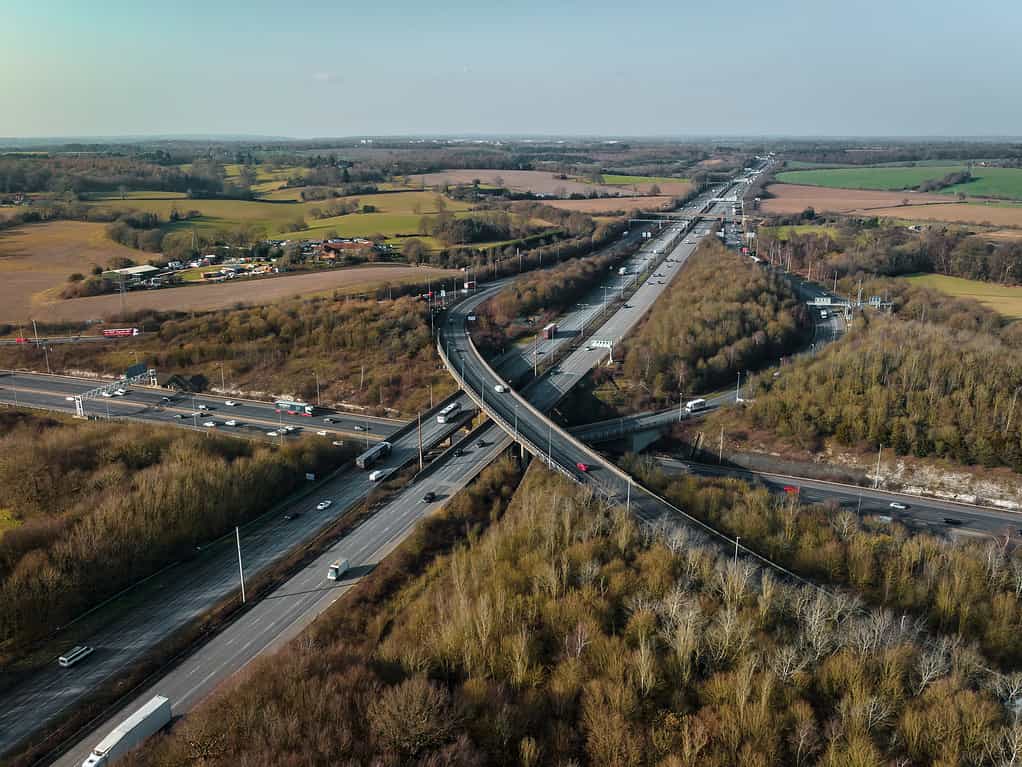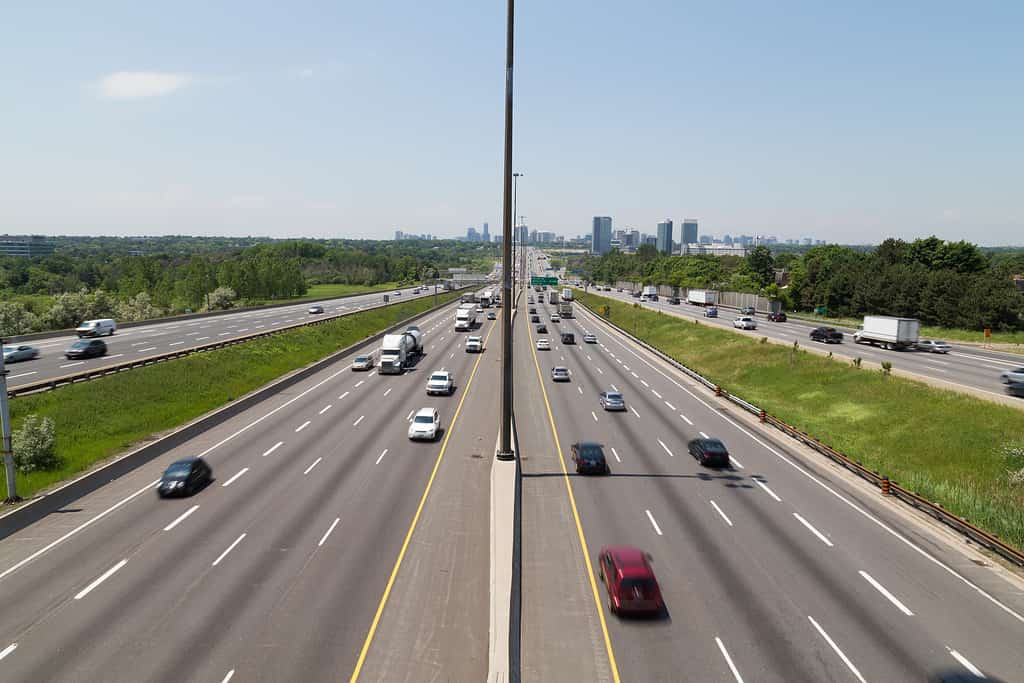The Widest Road in Canada Is Laughably Large!
Have you ever wondered who makes up the road systems, who names them and picks their size? In truth, there are different-sized roads. Some roads are larger than others. As a result, it offers drivers more space to travel. While some roads are narrow, barely giving you enough space to fit your car!
Who is in charge of these things, of choosing what road goes where? Who decided to make the widest road in Canada laughably large?
The Federal Highway Administration is in charge of setting up the roadways of North America. This agency is located within the Department of Transportation. Also, it helps state and local governments design and build their city and state roadways.

©CloudVisual/iStock via Getty Images
What Size Are Canada’s Roads?
The average width of a lane on the road is approximately 12 feet long; meanwhile, the shoulder is anywhere from 0 to 6 feet long, depending on the traffic that flows over the road. The US Department of Transportation has put together tables of information showing you the different sizing of different types of roads.
First, we need to look at roads in general. There are three different categories of roads — all having their size, speed, and mobility requirements. The three separate roadways are:
- Arterial
- Collector
- Local
A great example of an arterial road is the interstate system. Mainly, they have the highest speeds and traffic volume. Arterial roads are the highest classification of roadways in the United States. It is the largest group and contains several different types of roads. Be that as it may, these are freeways and multi-lane highways.
So, the interstate roads are running across the United States (statewide). What about the roads that connect you to the interstate? The main streets of the city you live in, the main road that you take out to that specific county line. This type of road is called a collector. Although not as big as a statewide road, they are bigger than a minor road connecting the smaller parts of the state with the arterial road. There are two types of collectors: a major collector and a minor collector. As a result, the major collector road will be the most important of the two. Having a higher speed limit and higher traffic volume. Residential and commercial areas are where you find minor collector roads.
Lastly, we have the smaller of the three, the local roads. Local roads provide you access to your town. This leads to residential areas and businesses that you want to visit.
What Is the Widest Road in Canada?
With all this talk of roads and their sizes, I wonder, what is the widest road in Canada? As I have shown, we know it will be an arterial road. Arterial roads are structurally built as the largest type of roadway. Not to mention, they can withhold the most weight and pressure. This means there is a good possibility that the widest road in Canada could be an arterial road.
In spite of being known to the locals as “Highway 401,” the actual name of the roadway is the Macdonald-Cartier Freeway. Whereas ScienceStruck states, some people refer to it as the 401. This freeway starts in Windsor in southwestern Ontario, traveling to Quebec, which is located in the east-central portion of Canada.

©mikeinlondon/ iStock / Getty Images Plus via Getty Images
What Makes It So Wide?
Highway 401 has 18 lanes across its passageway, with four lanes built onto their connecting rampways. Totaling 22 lanes that spread across it. Suppose you do all of the math at 12 feet per lane. That is well over 264 feet of pavement if you’re not including the shoulders of the road. That is 88 years!! 88 yards of road for the people of Canada to use for transportation.
Due to the sizing of the road, we assumed it would be an arterial road, for Highway 401 has high traffic volume. Nevertheless, there has been debate as to what Highway 401 is. A highway, a freeway, a street, or a road. We know it is not a part of the interstate system.
Don’t Forget the Upkeep!
Keeping Highway 401 in proper ordinance can be a challenge. As one of the widest roads in Canada, you would not expect anything less. For a visual, I have read that in one day, up to 40,000 vehicles access this Highway.
Not only is the structural integrity of the Highway critical, but you also need to consider the lives that cross it. A road that large has a high rate of traffic accidents.
“The Highway 401 system consists of colour CCTV cameras, LED type changeable message signs, vehicle detection stations and vehicle detectors to manage traffic on Highway 401.”
Road Traffic Technology highlists this, when discussing the requirements needed to run Highwy 401 correctly.

©Aphithana Chitmongkolthong/iStock / Getty Images Plus via Getty Images
Are There Any Others?
Yes, there are. A lot of things require us to have larger roadways. First and foremost, our growing economy and population. There are [so far anyway] no limits to life. In August 2023, traffic on the roadways increased by 2.4% from the previous year, according to the Federal Highway Administration.
“Travel for the month is estimated to be 288.4 billion vehicle miles.”
With such tremendous traffic volume, North America’s roads must be adjusted. This ensures they fit all of our transportation needs. It is understandable how roads with so many lanes can be a necessity, especially in those high-traffic areas. Larger cities, for example.
9 De Julio Avenue
This wide street is located in Brazil. It is a total of 16 lanes wide, and as a street, we know those lanes to be anywhere from 20-24 feet wide, meaning the lanes are anywhere from 10-12 feet wide. The 9 de Julio Avenue is around 160-190 feet across.
Monumental Axis
Brazil seems to hold several wide roads, for Brasilia’s capital city is Brasilia, an avenue that carries 12 lanes across its concrete. The Guinness Book of Records held a file for the Monumental Axis because it had the largest median in the world.
Katy Freeway
They are considered a part of the interstate system, known as Interstate 10, located in Texas. Increasing traffic levels are changing the structure needed for the roadway. Therefore, the freeway is being widened. This will make it have 26 lanes, ultimately wider than the road in Canada. Katy Freeway will have 12 main lanes, 8 access road lanes, and 6 mid-freeway lanes.
Final Thoughts
You have read how the Department of Transportation and the Federal Highway Administration construct our roadways. You know now that there are different classifications of roads. We are also understanding that they are distributed into three different categories. These categories help us decipher their size and traffic volume.
Through doing such, we have learned of The Widest Road in Canada Is Laughably Large and how it got to be that way. We also have now to understand why wider roads are necessary.
It is safe to say that finding these wider roadways in more locations than just one is necessary. They are popping up in places like the United States and South America. They, too, have roads built wider to help with the ebb and flow of traffic.
To conclude, if you are ever in one of these locations, I suggest you check them out to see if they are as big as they claim to be. Also, you need to check out our other article The Widest Road In The United States is Laughably Large.









